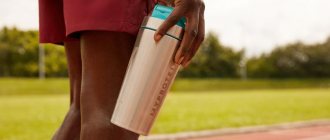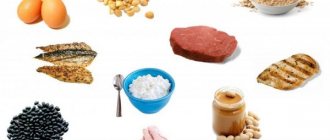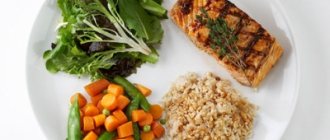April 18, 2015 Admin Home page » For weight gain
This article details the importance of carbohydrates and proteins after a workout for weight gain, how long you need to take them, provides a list of carbohydrate and protein foods at the end of the workout, and also describes proper nutrition after late evening workouts.
Before you start, I recommend learning about the importance of pre-workout nutrition for gaining weight.
Eating after a workout
Be sure to eat after training to gain weight within 30 minutes, you need to take food rich in carbohydrates and proteins, this period of time is called the carbohydrate window, at this time the muscles are exhausted and, like a sponge, absorb everything that you send them.
This is the same case when you can safely eat carbohydrates with a high level of the glycemic index; the calories will go directly to restoring glycogen reserves, and not to subcutaneous fat.
The protein will be used to restore damaged muscle areas and do not forget that usually training takes place in the evening, after which physical activity decreases, excess calories from protein do not go into fat, even the undigested part is excreted by the body through increased kidney function.
Subscribe to groups on social networks (VKontakte, Odnoklassniki, Facebook, Twitter, Yandex Zen), it’s very easy to find us, just write Bomb body in the search for the desired group!
Secrets of the professionals
Nutritionists and trainers say that in order to lose weight, it is forbidden to starve or overeat. When compiling a diet, you need to take into account the proportions of dietary supplements, vitamins, and minerals. Dishes should be varied, and food should be taken at least 5 times a day in small portions and at the same time. In addition, do not forget about your diet. Only by following these rules can you lose weight without harm to your health.
Valery Prokopyev, coach
According to a leading fitness trainer in Moscow, you should not adopt someone else’s experience of training to lose weight. It is best to create your own weight loss program with a personal trainer.
V. Prokopyev advises combining strength training with cardio exercises to speed up fat burning. It is worth knowing that the fat burning process begins 20-40 minutes after the start of the training.
Immediately after exercise, you need to close the carbohydrate window in order to lose weight for another hour.
Mikhail Ginzburg, nutritionist
A well-known nutritionist, Doctor of Medical Sciences, highlights the basic rules for losing weight during training:
- Don't go on strict diets. Any mono-diets (cottage cheese, kefir, buckwheat, etc.) are harmful to the body. Only a balanced, proper diet can saturate the body with useful substances and accelerate fat burning.
- Drink at least 2 liters of water per day.
- Eat food every 4 hours.
- Dinner should be light; eat the most high-calorie foods in the first half of the day.
- Combine strength training with anaerobic training.
- If you really want something sweet, then allow yourself to eat a small piece of dark chocolate.
- Replenish your diet with fruits with a minimum amount of starch (avocados, citrus fruits, apples, etc.).
If you follow these rules, within 4-8 weeks you will notice amazing external and internal changes.
Alexey Barannikov, coach
According to an experienced trainer, the most important meals are before and after exercise. 2-3 hours before training, you need to recharge with carbohydrates and proteins, for example, rice with boiled chicken. 30 minutes before exercise you need to consume carbohydrates (150 g of oatmeal or fruit). After training, you must close the carbohydrate window, and after 1.5 hours, eat foods rich in proteins and complex carbohydrates. This is necessary to restore strength and speed up fat burning. A professional trainer recommends playing sports in the fresh air.
Carbohydrates after exercise
It was already described above that you need to take fast carbohydrates with a high index level in order to sharply increase the level of insulin in the blood, which at this moment has an anabolic effect and prevents muscle destruction.
Carbohydrates are necessary to replenish the energy deficit, which a lot of it took to perform physical exercises; if this is not done in time, the body will begin to draw it from the muscles , triggering catabolic processes in full.
After training, you need to take from 60 to 100 grams of carbohydrates.
Grocery list:
— Porridge (barley, rice, buckwheat, oatmeal) — Pasta — Bread — Juice — Bananas — Honey (but don’t overdo it)
Natural nutrition for the masses
Remember, to increase muscle volume, protein is needed, without it all efforts are in vain. When it enters the body, the protein breaks down into amino acids, which, when released into the muscle tissue, make it thicker, that is, the muscles grow.
During high-intensity training, muscle fibers are torn, receiving microtraumas, protein heals them, like using a brick for a house, making the muscle bigger and bigger.
A very important rule is that protein is well absorbed with the help of carbohydrates; without them, the process goes worse. In other words, after eating chicken breast or turkey, at the same time take pasta, rice, oatmeal, buckwheat and other types of carbohydrates, as well as vegetables. Give preference to carbohydrates with a low glycemic index; they release calories slowly and do not contribute to the accumulation of subcutaneous fat.
Season vegetable salads with sunflower or flaxseed oil, forget what mayonnaise is, it contains 100g. about 67% fat, more than the daily value, if you are such a big fan of mayonnaise, use sour cream with a fat content of no more than 15%.

For breakfast, eat eggs, making an omelet out of them, or drink them just like that, use 1 whole egg and 4-5 egg whites. Very well fueled with calories for the whole day - oatmeal, buckwheat or rice, love these dishes in the morning. Breakfast is the most important meal of the day, so tea and cookies won’t work; you need to try to get as much protein and carbohydrates into yourself as possible.
For dinner, you also need to eat proteins and carbohydrates, and after training, give 60% carbohydrates, 40% proteins and 10% fats; on rest days, dinner should be 60% protein, 40% carbohydrates and 10% fats. During dinner, avoid eating confectionery; it is better to do this in the morning; during the day, excess calories will be burned, but before bed there is almost no movement and they will go into fat.
Actively consume fish in its own juice, especially tuna, salmon, pollock, hake - they contain a decent amount of protein and have Omega 3, 6 and 9 fatty acids, which do not make you fat, but on the contrary, they help fight fat deposits by breaking them down.
Eat frequently 5-6 times, dividing meals into small ones, so you do not overload your stomach and ensure a constant supply of nutrients to muscle tissue.
Protein after workout
After finishing your workout, drink protein as soon as possible, preferably whey, it has a rapid degree of digestibility; it also doesn’t hurt to take BCAA in the amount of 5-8g. and gainer. In this case, protein synthesis in the muscles will increase 3 times, compared to if you do not eat after training.
Protein also has a beneficial effect on muscle tissue, restoring it after heavy training. The amount of protein should be at least 20-30g.

Grocery list:
— Chicken fillet, turkey, lean beef — Fish — Cottage cheese — Egg whites
For a more detailed list of foods containing a lot of protein, see here.
Compatibility of cardio and mass gain phases
When asking the question: “is cardio good or bad, or normal?”, you need to take into account that the answer depends on how you use cardio.
To clarify, the main method of cardio that I will talk about in this article will be from light to moderate intensity. Interval cardio will definitely be a hindrance for us when gaining mass.
Of course, you may find someone who can benefit from this type of cardio, but for most, I think this type of training is not suitable (interval training and others like it) when the goal is to increase muscle mass. So I'll be focusing on low to moderate intensity for my cardio sessions.
Benefits of Cardio While Gaining Muscle
Among the advantages of cardio, which is performed in a certain amount during the gaining phase, I would highlight the following points:
- Improved recovery
- Increased appetite
- Maintaining some condition and performance
- Improved calorie portions
- Allows the fat burning mechanism to work systematically
Let's now look at these points.
Improved recovery
Using cardio at a light to moderate intensity (I'll get to the specifics towards the end of the article), cardio can be a form of active recovery. By pumping blood out of the working muscles, recovery always speeds up (and for most, active recovery helps more than passive recovery - that is, when you do nothing).
I note that cardio sessions most often use the lower part of the body, so it will give the greatest effect to that part of your body. Trainers who want to achieve the same effect, but for the upper body, should do rowing, or use an EFX (something like an orbitrack), or a similar “simulator” that uses the upper body to a certain extent.
Finally, it is worth saying that drinking a carbohydrate/protein mixture (probably about 30 grams of carbohydrates and half as much protein, every hour) will increase blood flow to the working muscle, which in turn will saturate it with nutrients. This will also help with recovery.
Appetite
The effect of physical activity on appetite can be quite different. For some people, activity, namely vigorous activity, can dull the appetite. For others, such activity may, on the contrary, increase their appetite. Regarding appetite gain, exercisers who have trouble consuming enough calories find that adding a moderate amount of cardio helps them increase their appetite.
Conditioning and Performance Support
Depending on the type of training, it is not uncommon for a lifter or bodybuilder to experience a loss of certain metabolic conditioning when they engage in bulking cycles (during which their work is reduced to just training in the gym). Low repetitions, long rests between sets, etc., lead to people losing their overall condition and performance during this cycle.
This is quite bad for athletes, because in the end they will need to purchase everything almost from scratch. Even not just for lifters (like bodybuilders), losing your performance can harm your overall recovery, both during and between workouts.
There is, of course, a good nuance here: it takes quite a bit of training time to maintain a certain condition. Rather than doing it all over again from scratch.
Improved caloric portion size
As an additional benefit, aerobic exercise can improve performance during the bulking phase in yet another way. This applies to calories. As I discussed in Calorie Partitioning Part 1 and Calorie Partitioning Part 2, portion size depends on where the calories go and where they came from, depending on whether you overate or underate. Probably the best way to divide calories into portions is during the training process. Systematic activity increases nutrient uptake by skeletal muscles. In practice, this means that fewer “extra” calories will go into reserve (i.e., into body fat). While the debate rages on about the benefits of light-optimal cardio sessions, it is becoming clear that such cardio workouts won't do any harm. It may even help in the long run.
Stay dry, burn fat
Finally, there is the problem of keeping fat burning active or staying dry while bulking. To be honest, I'm not entirely sure that even if a person does a ton of cardio, it will help him stay dry. Especially considering that in this case it becomes much easier to eat more calories, and cardio itself does not burn so many calories. Again, I suspect it would be easier to keep the calories under control.
However, there is another related reason to this question to leave cardio when recruiting. Many people, when gaining weight, do not want to gain fat. I have already discussed in General Philosophies of Muscle Mass Gains that the fastest results in muscle mass growth are observed when a little fat mass is also deposited along with it. Eventually, this will require dieting to get rid of the accumulated fat.
Now, absolutely the opposite case. One of the reasons why cardio gets a bad rap (which I can't get into completely in this article) when it comes to losing muscle mass on a diet is because people jump out of the frying pan and into the fire. That is, initially they didn’t do cardio at all, and then they start doing it from dawn to dusk. In parallel with this, calories are also being cut below the baseboard. And, I believe that it is precisely this “combo” that gives the effect of muscle collapse.
There is a problem that when a person eats quite heavily over a period of time, which is necessary to create maximum gains in muscle mass, the body loses some of its ability to utilize fat as fuel. And it can take a couple of weeks to “regain” this ability when calories are already restricted (I suspect this explains some of the strange delays that seem to occur during fat loss in people who have started dieting again).
This is very noticeable when people do not use cardio during the period of mass gain. By doing the right amount of cardio during the bulking phase, your ability to utilize fat for fuel will eventually be maintained. And when the “weight loss” phase begins, it will be easier for the body to respond to this type of load and utilize fat reserves as a source of energy.
Cardio Disadvantages During the Bulk Phase
Looking at "pro" bodybuilders who leave at least a little cardio while bulking, I want to discuss with you two main disadvantages:
- Burns calories, which can interfere with meat gain.
- May impair recovery (overtraining).
Burns calories, which may interfere with meat gain
These two aspects are some of the most important that can influence a trainee to eliminate cardio during the bulking phase. Since the calories will not be spent on muscle growth, but on cardio training.
As we said earlier, calorie utilization during aerobic training of a light-moderate intensity is actually not great.
Naturally, this applies to those who know how to use this principle, since there may be unique people who will burn a lot of calories using this method of training. The several hundred calories that will be burned during such a workout are quite easy to spread out over a certain number of days. I don't think this is a big problem in terms of calorie and protein costs for muscle growth.
One exception to this is chronically thin people (typical hardgainers or ectomorphs). These are those people who already find it difficult to gain weight for a certain number of reasons (I talked about this in another article on my website). Since they rarely have to think about how to lose weight, they sometimes need to avoid a lot of cardio so that all their energy and food eaten is used for training and muscle growth.
There may also be exceptions to this exception, remember what I said about appetite? The typical ectomorph/hardgainer always has trouble eating the right amount of calories (one reason is that they need to stay dry, and when they start eating a lot or overeating, their appetite sends them away for a long time). In such a situation, I would suggest a certain amount of cardio on non-workout days as this would help their appetite.
May impair recovery (overtraining)
The last two points are quite intertwined with each other, so we will consider them as one whole. The main problem is that combining heavy gym training with heavy aerobic training will impair performance in the gym. There is a grain of truth in this.
A large amount of previous research (and practical experience) suggests that combining these two types of training will interfere with results in both areas.
Interestingly (and beyond the scope of this article), when cardiovascular training impairs strength performance, I have not noticed the opposite. That is, heavy gym training does not appear to impair endurance training adaptations.
Now, another thing to remember is that most athletes reading this article have been doing fairly intense cardio. Which can be compared, in terms of intensity, to American football, or something similar. So they didn't do much right based on the information in this article. Intensity is a key factor, for many reasons that are beyond the scope of this article. When intensity is reduced and volume and frequency become more optimal, the negative impact of such training on strength training adaptations is significantly reduced.
I will emphasize that excessive use of cardio sessions can impair your recovery both overall and in specific muscle groups (meaning either your whole body will be fatigued or the effects of overtraining will be localized). The legs can suffer the most, which is logical, since most cardio movements are associated with the lower part of our body. Even excessive amounts of low-intensity cardio can greatly reduce recovery.
Are we “for” or “against” cardio during mass gain?
I believe that even with hard gainer/skinny guys (who may use cardio to improve their appetite), the benefits of cardio outweigh the downsides.
I simply feel that most problems with cardio come from too much and too much cardio. If you control the amount of anaerobic training and its intensity, keep it optimal, then I see no reason for any problems to arise.
So what is optimal and smart cardio? At least 20-30 minutes of cardio, three times a week, will support your cardiovascular system, burn some calories, provoke active recovery and help the fat burning mechanism work in the future, which will make progress better and faster when you go on a diet. And you'll get all these positive results without negatively impacting your performance in the gym.
Of course, you can use it more often, but I don’t see the point in doing it more than 5 times a week, unless the intensity is very low (for example, you can walk briskly every day if necessary). Walking longer than at least 20-30 minutes will burn more calories, but there is a certain time limit (because then people get bored). I would set a reasonable limit of 40 minutes of moderate intensity, which would be the maximum I used. If the intensity was lower (again, walking at a brisk pace), you could train for the full 60 minutes.
In terms of intensity, I think keeping the intensity of the workout "light-moderate" is the best choice. More specifically, 70% of the maximum intensity of heart contractions (for some, 140 beats per minute, with a maximum intensity of 200 beats). Or even lower! This way you can get certain benefits without getting into overtraining or slowing down your weight gain.
As I said in the first part of the article, this is pretty close to the bodybuilding tradition of athletes walking on a treadmill for an hour every morning. While I think this is unnecessary for chatter, the intensity is quite low here. And bodybuilders have been using this principle for many years and quite successfully. So this is a pretty good axiom for our fact.
The last nuance that we will consider is timing, that is, when to do cardio. If we lived in an ideal world and conditions, then, of course, doing cardio training would be separate from strength training. Cardio in the morning (fasted or not) and strength training in the evening is ideal. But this is quite difficult to translate into reality, taking into account the fact that people study, work, have families, etc.
A very common approach is to do cardio on days you are NOT working out, and this can work great if your schedule allows it. Of course, not everyone can do this for a number of reasons. There is the following way out for you: walk to the hall for 20-30 minutes. In practice, it turns out that cardio is performed together with iron training. And the question immediately pops up: “should I do cardio “BEFORE” or “AFTER” the workout?”
If the intensity of the cardio session is low, then it will not harm an intense workout in the gym (just think of it as a long warm-up). If you do cardio “after”, then it will no longer interfere with your strength training, however, those who take it too seriously that after training they need to close the carbohydrate-protein window will postpone their meal. Therefore, it would be wise to drink your post-workout mixture during your cardio.
I want to point out that after a hard leg workout, many people won't want to do cardio. Therefore, you can do 20 minutes of low-intensity cardio. If there was an upper body workout, then the cardio may last longer and/or more intense (but within the reasonable limits that we discussed with you).
Let's summarize
To summarize, in most cases, I believe that performing cardio at an optimal frequency and intensity, even when the goal is to gain muscle mass, will be beneficial for most athletes (the exception may be unrealistically tight pimples).
The really significant benefits are:
- Improved recovery.
- Improved performance.
- Improves caloric intake and portion size.
- Appetite improves (sometimes).
- We remain somewhat drier.
- In the long term, it is easier to diet during the “fat burning” phase.
The disadvantages are that only if the intensity and frequency of training is uncontrolled, recovery can be impaired.
Doing at least 3 times a week cardio (maximum 5 times a week) for the right amount of time (20-30 minutes minimum and probably 40 minutes maximum) at low/moderate intensity (70% of maximal heart rate, or less) will achieve you will receive the benefits that we discussed above, without any negative consequences.
Original. Translated by HUMAN.
Nutrition for weight loss after exercise
The information does not quite fit the title of the article, but it will be useful for those who, having gained muscle mass, want to better draw their figure, get rid of excess fat, leaving clean meat.
Immediately after training, do not eat food, only after 2-3 hours, the exception is protein up to 20g, BCCA - 5g. and amino acids. Why is this so??? Taking protein, BCCA and amino acids keeps muscles from breaking down, and eliminating carbohydrates immediately after training forces the body to get energy by breaking down fat deposits.
At the end of 2-3 hours, you should take slow carbohydrates, which gradually release energy to the body and then in small quantities. Before going to bed, you should take casein protein.
Sports nutrition intake schedule
In the morning, immediately after waking up
BSN Syntha-6: 20 g
Universal complex protein, contains 6 different types of protein with different rates of absorption, from slow casein to fast isolate.
Twinlab L-Arginine: 2-3 g
Amino acid arginine! Stimulates muscle growth processes!
MusclePharm Glutamine: 7-10 g
Quick replenishment of strength after a grueling workout!
In the first half of the day
BSN Syntha-6: 20 g
Universal complex protein, contains 6 different types of protein with different rates of absorption, from slow casein to fast isolate.
Before training
BSN Syntha-6: 20 g
Universal complex protein, contains 6 different types of protein with different rates of absorption, from slow casein to fast isolate.
Twinlab L-Arginine: 2-3 g
Amino acid arginine! Stimulates muscle growth processes!
MusclePharm Glutamine: 7-10 g
Quick replenishment of strength after a grueling workout!
Optimum Nutrition BCAA 1000 Caps: 5-10 g
Essential amino acids for building lean muscle mass and reducing muscle loss during cutting!
BSN Evotest: 1 serving
Testosterone booster. Enhances testosterone secretion even with initially normal hormone levels!
After training
BSN Syntha-6: 20 g
Universal complex protein, contains 6 different types of protein with different rates of absorption, from slow casein to fast isolate.
Universal Nutrition Casein Pro: 20 g
100% micellar casein 24 grams of casein per serving!
Optimum Nutrition Micronized Creatine Powder: 3-5 g
Pure creatine monohydrate. Increases strength and accelerates muscle growth!
MusclePharm Glutamine: 7-10 g
Quick replenishment of strength after a grueling workout!
30-60 minutes before bedtime
Universal Nutrition Casein Pro: 20 g
100% micellar casein 24 grams of casein per serving!
MusclePharm Glutamine: 7-10 g
Quick replenishment of strength after a grueling workout!
Twinlab L-Arginine: 2-3 g
Amino acid arginine! Stimulates muscle growth processes!
In the middle of the night
So, this is a rough plan for taking sports nutrition to gain muscle mass. We have already answered all questions regarding the timing and dosage of medications, so you can start gaining muscle mass right now. A beginner may think that there are too many drugs, in which case we advise you to start with whey protein, and then gradually add other drugs to it and evaluate their effectiveness from personal experience. We are all different, and therefore some drugs will suit some people, while others will choose other nutrients.

And do not forget about a complete and balanced diet, without which not a single drug will save a bodybuilder from a catabolic nightmare. Eat enough complex carbohydrates, which are found in potatoes, durum wheat pasta, rice, wholemeal bread and oatmeal; Remember to eat protein-rich foods such as beef, turkey, chicken, eggs and fish. And you will find yourself on a path that will lead you to unprecedented muscle growth in no time!
Meal after evening workout
If you immediately go to bed after training, then 2 hours before the start of active physical activity, take a hearty dinner with carbohydrates, and after finishing, you definitely need casein protein in the amount of 30-40g. (gradually absorbed by the muscles until the morning, preventing the destruction of muscle tissue) and BCAA 5-8g, do not take carbohydrates at the end.
If it is not possible to take casein protein, use low-fat cottage cheese, it also contains a decent portion of casein.
Use this information to gain high-quality muscle mass, leave comments, the opinions of every reader are interesting, some want to criticize, and some want to praise, every detail is important to me. I wish you good luck, summer is coming











